
Sino-Roman relations
Encyclopedia
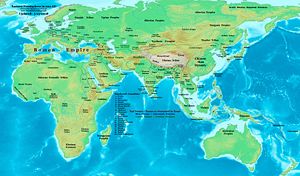
Roman Empire
The Roman Empire was the post-Republican period of the ancient Roman civilization, characterised by an autocratic form of government and large territorial holdings in Europe and around the Mediterranean....
and Han China progressively inched closer in the course of the Roman expansion into the Ancient Near East
Ancient Near East
The ancient Near East was the home of early civilizations within a region roughly corresponding to the modern Middle East: Mesopotamia , ancient Egypt, ancient Iran The ancient Near East was the home of early civilizations within a region roughly corresponding to the modern Middle East: Mesopotamia...
and simultaneous Chinese military incursions into Central Asia
Central Asia
Central Asia is a core region of the Asian continent from the Caspian Sea in the west, China in the east, Afghanistan in the south, and Russia in the north...
. However, powerful intermediate empires such as the Parthians
Parthian Empire
The Parthian Empire , also known as the Arsacid Empire , was a major Iranian political and cultural power in ancient Persia...
and Kushans
Kushan Empire
The Kushan Empire originally formed in the early 1st century AD under Kujula Kadphises in the territories of ancient Bactria on either side of the middle course of the Oxus in what is now northern Afghanistan, Pakistan, and southern Tajikistan and Uzbekistan.During the 1st and early 2nd centuries...
kept the two Eurasian flanking powers permanently apart and mutual awareness remained low and knowledge fuzzy.
History
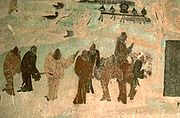
Western Regions
The Western Regions or Xiyu was a historical name specified in the Chinese chronicles between the 3rd century BC to 8th century AD that referred to the regions west of Jade Gate, most often Central Asia or sometimes more specifically the easternmost portion of it The Western Regions or Xiyu was a...
" in the 2nd century BCE, with the embassy of Zhang Qian
Zhang Qian
Zhang Qian was an imperial envoy to the world outside of China in the 2nd century BCE, during the time of the Han Dynasty...
.
The Roman historian Florus
Florus
Florus, Roman historian, lived in the time of Trajan and Hadrian.He compiled, chiefly from Livy, a brief sketch of the history of Rome from the foundation of the city to the closing of the temple of Janus by Augustus . The work, which is called Epitome de T...
describes the visit of numerous envoys, including Seres
Seres
Seres was the ancient Greek and Roman name for the inhabitants of eastern Central Asia. It meant "of silk," or people of the "land where silk comes from." The country of the Seres was Serica....
(Chinese, or, more probably Central Asians), to the first Roman Emperor Augustus, who reigned between 27 BCE and 14:
- "Even the rest of the nations of the world which were not subject to the imperial sway were sensible of its grandeur, and looked with reverence to the Roman people, the great conqueror of nations. Thus even Scythians and SarmatiansSarmatiansThe Iron Age Sarmatians were an Iranian people in Classical Antiquity, flourishing from about the 5th century BC to the 4th century AD....
sent envoys to seek the friendship of Rome. Nay, the SeresSeresSeres was the ancient Greek and Roman name for the inhabitants of eastern Central Asia. It meant "of silk," or people of the "land where silk comes from." The country of the Seres was Serica....
came likewise, and the IndiaIndiaIndia , officially the Republic of India , is a country in South Asia. It is the seventh-largest country by geographical area, the second-most populous country with over 1.2 billion people, and the most populous democracy in the world...
ns who dwelt beneath the vertical sun, bringing presents of precious stones and pearls and elephants, but thinking all of less moment than the vastness of the journey which they had undertaken, and which they said had occupied four years. In truth it needed but to look at their complexion to see that they were people of another world than ours."
In 97 CE, the Chinese general Ban Chao
Ban Chao
Ban Chao , courtesy name Zhongsheng , was born in Xianyang, Shaanxi, and the younger brother of the famous historian, Ban Gu who, with his father Ban Biao, and sister, Ban Zhao, wrote the famous Hanshu, or 'History of the Former Han Dynasty'....
unsuccessfully tried to send an envoy to Rome
Rome
Rome is the capital of Italy and the country's largest and most populated city and comune, with over 2.7 million residents in . The city is located in the central-western portion of the Italian Peninsula, on the Tiber River within the Lazio region of Italy.Rome's history spans two and a half...
. Several alleged Roman emissaries to China were recorded by ancient Chinese historians. The first one on record, supposedly from either the Roman emperor
Roman Emperor
The Roman emperor was the ruler of the Roman State during the imperial period . The Romans had no single term for the office although at any given time, a given title was associated with the emperor...
Antoninus Pius
Antoninus Pius
Antoninus Pius , also known as Antoninus, was Roman Emperor from 138 to 161. He was a member of the Nerva-Antonine dynasty and the Aurelii. He did not possess the sobriquet "Pius" until after his accession to the throne...
or the later emperor Marcus Aurelius, arrived in 166. The Hou Hanshu records the arrival of Roman envoys, by sea to Chinese territory in what is now North Vietnam
North Vietnam
The Democratic Republic of Vietnam , was a communist state that ruled the northern half of Vietnam from 1954 until 1976 following the Geneva Conference and laid claim to all of Vietnam from 1945 to 1954 during the First Indochina War, during which they controlled pockets of territory throughout...
in 166 CE, presumably from either the Roman emperor
Roman Emperor
The Roman emperor was the ruler of the Roman State during the imperial period . The Romans had no single term for the office although at any given time, a given title was associated with the emperor...
Antoninus Pius
Antoninus Pius
Antoninus Pius , also known as Antoninus, was Roman Emperor from 138 to 161. He was a member of the Nerva-Antonine dynasty and the Aurelii. He did not possess the sobriquet "Pius" until after his accession to the throne...
or the later emperor Marcus Aurelius. The text specifically states that it was the first time there had been direct contact between the two countries.

Silk Road
The Silk Road or Silk Route refers to a historical network of interlinking trade routes across the Afro-Eurasian landmass that connected East, South, and Western Asia with the Mediterranean and European world, as well as parts of North and East Africa...
) and sea routes included Chinese silk
Silk
Silk is a natural protein fiber, some forms of which can be woven into textiles. The best-known type of silk is obtained from the cocoons of the larvae of the mulberry silkworm Bombyx mori reared in captivity...
, Roman glassware, high-quality cloth, spices, perfumes, gems, etc.
The Liangshu records the arrival in 226 CE of a merchant from the Roman Empire (Da Qin) at Jiaozhi
Jiaozhi
Jiaozhi was the name of all or part of Vietnam's territory, from the Hùng Vương era to the middle of the Third Chinese domination, and during the Fourth Chinese domination.-Giao Chỉ in the Văn Lang era:...
(near modern Hanoi
Hanoi
Hanoi , is the capital of Vietnam and the country's second largest city. Its population in 2009 was estimated at 2.6 million for urban districts, 6.5 million for the metropolitan jurisdiction. From 1010 until 1802, it was the most important political centre of Vietnam...
). The Prefect of Jiaozhi sent him to Sun Quan
Sun Quan
Sun Quan , son of Sun Jian, formally Emperor Da of Wu, was the founder of Eastern Wu during the Three Kingdoms period of Chinese history. He ruled from 222 to 229 as King of Wu and from 229 to 252 as Emperor of Wu....
[the Wu (kingdom) emperor], who asked him for a report on his native country and its people. An expedition was mounted to return the merchant to along with 10 female and 10 male "blackish coloured dwarfs" he had requested as a curiosity and a Chinese officer who, unfortunately, died enroute.
In classical
Classical antiquity
Classical antiquity is a broad term for a long period of cultural history centered on the Mediterranean Sea, comprising the interlocking civilizations of ancient Greece and ancient Rome, collectively known as the Greco-Roman world...
sources, the problem of identifying references to ancient China is exacerbated by the interpretation of the Latin
Latin
Latin is an Italic language originally spoken in Latium and Ancient Rome. It, along with most European languages, is a descendant of the ancient Proto-Indo-European language. Although it is considered a dead language, a number of scholars and members of the Christian clergy speak it fluently, and...
term "Seres
Seres
Seres was the ancient Greek and Roman name for the inhabitants of eastern Central Asia. It meant "of silk," or people of the "land where silk comes from." The country of the Seres was Serica....
" whose meaning fluctuated and could refer to a number of Asian people in a wide arc from India
India
India , officially the Republic of India , is a country in South Asia. It is the seventh-largest country by geographical area, the second-most populous country with over 1.2 billion people, and the most populous democracy in the world...
over Central Asia
Central Asia
Central Asia is a core region of the Asian continent from the Caspian Sea in the west, China in the east, Afghanistan in the south, and Russia in the north...
to China. In Chinese records, the Roman Empire came to be known as "Da Qin", Great Qin, apparently thought to be a sort of counter-China at the other end of the world. According to Pulleyblank, the "point that needs to be stressed is that the Chinese conception of Da Qin was confused from the outset with ancient mythological notions about the far west".
Asian silk in the Roman Empire

Roman commerce
Roman trade was the engine that drove the Roman economy of the late Republic and the early Empire. Fashions and trends in historiography and in popular culture have tended to neglect the economic basis of the empire in favor of the lingua franca of Latin and the exploits of the Roman legions...
, confirmed by the Roman
Ancient Rome
Ancient Rome was a thriving civilization that grew on the Italian Peninsula as early as the 8th century BC. Located along the Mediterranean Sea and centered on the city of Rome, it expanded to one of the largest empires in the ancient world....
craze for silk
Silk
Silk is a natural protein fiber, some forms of which can be woven into textiles. The best-known type of silk is obtained from the cocoons of the larvae of the mulberry silkworm Bombyx mori reared in captivity...
, started in the 1st century BCE. Although the Romans knew of wild silk
Wild silk
Wild silks have been known and used in many countries from early times, although the scale of production is far smaller than that from cultivated silkworms.-Background:...
harvested on Cos
Kos
Kos or Cos is a Greek island in the south Sporades group of the Dodecanese, next to the Gulf of Gökova/Cos. It measures by , and is from the coast of Bodrum, Turkey and the ancient region of Caria. Administratively the island forms a separate municipality within the Kos peripheral unit, which is...
, they did not at first make the connection with silk which was also produced in the Pamir
Pamir
Pamir may refer to:* a pamir, a U-shaped grassy valley in the Pamir Mountains**Great Pamir, a high valley in the Wakhan on the border of Afghanistan and Tajikistan**Little Pamir, a high valley in the Wakhan, Afghanistan...
Sarikol kingdom
Sarikol
Sarikol, Sariqol, or Sarykol may refer to:* Sarikol kingdom, a historical kingdom of the Pamir Mountains, whose capital was at Tashkurgan* Sarikoli language, a Pamir language...
. There were few direct trade contacts between Romans and Han Chinese, as the rivalling Parthians
Parthian Empire
The Parthian Empire , also known as the Arsacid Empire , was a major Iranian political and cultural power in ancient Persia...
and Kushans
Kushan Empire
The Kushan Empire originally formed in the early 1st century AD under Kujula Kadphises in the territories of ancient Bactria on either side of the middle course of the Oxus in what is now northern Afghanistan, Pakistan, and southern Tajikistan and Uzbekistan.During the 1st and early 2nd centuries...
were each jealously protecting their lucrative role as trade intermediaries.
Much of what we know from the Roman side of the silk trade, and silk in general, comes from Pliny the Elder
Pliny the Elder
Gaius Plinius Secundus , better known as Pliny the Elder, was a Roman author, naturalist, and natural philosopher, as well as naval and army commander of the early Roman Empire, and personal friend of the emperor Vespasian...
, in his Natural History:
Pliny the Elder wrote about the large value of the trade between Rome and Eastern countries::
Yet, later in the same work, he writes:
The Senate
Roman Senate
The Senate of the Roman Republic was a political institution in the ancient Roman Republic, however, it was not an elected body, but one whose members were appointed by the consuls, and later by the censors. After a magistrate served his term in office, it usually was followed with automatic...
issued, in vain, several edicts to prohibit the wearing of silk, on economic and moral grounds: the importation of silk caused a huge outflow of gold, and silk clothes were considered to be decadent and immoral:
The Roman historian Florus
Florus
Florus, Roman historian, lived in the time of Trajan and Hadrian.He compiled, chiefly from Livy, a brief sketch of the history of Rome from the foundation of the city to the closing of the temple of Janus by Augustus . The work, which is called Epitome de T...
also describes the visit of numerous envoys, including Seres and "Indians" (who may have included Kushans), to the first Roman Emperor Augustus, who reigned between 27 BCE and CE 14
14
Year 14 was a common year starting on Monday of the Julian calendar. At the time, it was known as the Year of the Consulship of Pompeius and Appuleius...
:
A maritime route opened up with the Chinese-controlled Jiaozhi
Jiaozhi
Jiaozhi was the name of all or part of Vietnam's territory, from the Hùng Vương era to the middle of the Third Chinese domination, and during the Fourth Chinese domination.-Giao Chỉ in the Văn Lang era:...
(centred in modern Vietnam) and the Khmer
Khmer people
Khmer people are the predominant ethnic group in Cambodia, accounting for approximately 90% of the 14.8 million people in the country. They speak the Khmer language, which is part of the larger Mon–Khmer language family found throughout Southeast Asia...
kingdom of Funan by the 2nd century CE, if not earlier. At the formerly coastal site of Óc Eo
Óc Eo
Óc Eo is an archaeological site in Thoại Sơn District in southern An Giang Province, Vietnam, in the Mekong River Delta region of Vietnam. It is also one of the modern day communes of Vietnam. Óc Eo may have been a busy port of the kingdom of Funan between the 1st and 7th centuries AD...
in the Mekong Delta
Mekong Delta
The Mekong Delta is the region in southwestern Vietnam where the Mekong River approaches and empties into the sea through a network of distributaries. The Mekong delta region encompasses a large portion of southwestern Vietnam of . The size of the area covered by water depends on the season.The...
, Roman coins were among the vestiges of long-distance trade discovered by the French archaeologist Louis Malleret in the 1940s. Óc Eo may have been the port known to the geographer Ptolemy and the Romans as Kattigara or Cattigara, though most modern scholars place it at Jiaozhi, near modern Hanoi. The trade connection extended, via ports on the coasts of India and Sri Lanka
Sri Lanka
Sri Lanka, officially the Democratic Socialist Republic of Sri Lanka is a country off the southern coast of the Indian subcontinent. Known until 1972 as Ceylon , Sri Lanka is an island surrounded by the Indian Ocean, the Gulf of Mannar and the Palk Strait, and lies in the vicinity of India and the...
, all the way to Roman-controlled ports in Egypt
Egypt
Egypt , officially the Arab Republic of Egypt, Arabic: , is a country mainly in North Africa, with the Sinai Peninsula forming a land bridge in Southwest Asia. Egypt is thus a transcontinental country, and a major power in Africa, the Mediterranean Basin, the Middle East and the Muslim world...
and the Nabataean territories on the northeastern coast of the Red Sea
Red Sea
The Red Sea is a seawater inlet of the Indian Ocean, lying between Africa and Asia. The connection to the ocean is in the south through the Bab el Mandeb strait and the Gulf of Aden. In the north, there is the Sinai Peninsula, the Gulf of Aqaba, and the Gulf of Suez...
.
Roman exports to China
High-quality glassGlass
Glass is an amorphous solid material. Glasses are typically brittle and optically transparent.The most familiar type of glass, used for centuries in windows and drinking vessels, is soda-lime glass, composed of about 75% silica plus Na2O, CaO, and several minor additives...
from Roman manufactures in Alexandria
Alexandria
Alexandria is the second-largest city of Egypt, with a population of 4.1 million, extending about along the coast of the Mediterranean Sea in the north central part of the country; it is also the largest city lying directly on the Mediterranean coast. It is Egypt's largest seaport, serving...
and Syria
Syria
Syria , officially the Syrian Arab Republic , is a country in Western Asia, bordering Lebanon and the Mediterranean Sea to the West, Turkey to the north, Iraq to the east, Jordan to the south, and Israel to the southwest....
were exported to many parts of Asia, including Han China. Further Roman luxury items which were greatly esteemed by the Chinese were gold-embroidered rugs and gold-coloured cloth, asbestos
Asbestos
Asbestos is a set of six naturally occurring silicate minerals used commercially for their desirable physical properties. They all have in common their eponymous, asbestiform habit: long, thin fibrous crystals...
cloth and sea silk
Sea silk
Sea silk is an extremely fine, rare and valuable fabric produced from the long silky filaments or byssus secreted by a gland in the foot of several bivalve molluscs by which they attach themselves to the sea bed....
, a cloth made from the silk-like hairs of certain Mediterranean shell-fish, the Pinna nobilis
Pinna nobilis
Pinna nobilis, common name the "noble pen shell" is a species of pen shell, a large marine bivalve mollusc in the family Pinnidae, the 'pen shells'....
.
Envoy Gan Ying
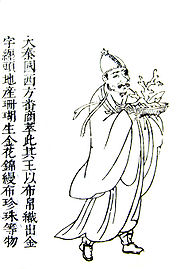
Gan Ying
Gan Ying , was a Chinese military ambassador who was sent on a mission to Rome in 97 CE by the Chinese general Ban Chao.Although Gan Ying never reached Rome, only travelling to as far as the Parthian coast of the Persian Gulf, he is, at least in the historical records, the Chinese who went the...
, sent by the general Ban Chao
Ban Chao
Ban Chao , courtesy name Zhongsheng , was born in Xianyang, Shaanxi, and the younger brother of the famous historian, Ban Gu who, with his father Ban Biao, and sister, Ban Zhao, wrote the famous Hanshu, or 'History of the Former Han Dynasty'....
, made his way from the Tarim Basin
Tarim Basin
The Tarim Basin is a large endorheic basin occupying an area of about . It is located in the Xinjiang Uyghur Autonomous Region in China's far west. Its northern boundary is the Tian Shan mountain range and its southern is the Kunlun Mountains on the northern edge of the Tibetan Plateau. The...
to Parthia and reached the Persian Gulf
Persian Gulf
The Persian Gulf, in Southwest Asia, is an extension of the Indian Ocean located between Iran and the Arabian Peninsula.The Persian Gulf was the focus of the 1980–1988 Iran-Iraq War, in which each side attacked the other's oil tankers...
. Gan Ying left a detailed account of western countries, although he apparently only reached as far as Mesopotamia
Mesopotamia
Mesopotamia is a toponym for the area of the Tigris–Euphrates river system, largely corresponding to modern-day Iraq, northeastern Syria, southeastern Turkey and southwestern Iran.Widely considered to be the cradle of civilization, Bronze Age Mesopotamia included Sumer and the...
, then under the control of the Parthian Empire
Parthian Empire
The Parthian Empire , also known as the Arsacid Empire , was a major Iranian political and cultural power in ancient Persia...
. While he intended to sail to the Roman Empire, he was discouraged when told that the dangerous trip could take up to two years. Deterred, he returned home to China bringing much new information on the countries to the west of Chinese-controlled territories.
Gan Ying
Gan Ying
Gan Ying , was a Chinese military ambassador who was sent on a mission to Rome in 97 CE by the Chinese general Ban Chao.Although Gan Ying never reached Rome, only travelling to as far as the Parthian coast of the Persian Gulf, he is, at least in the historical records, the Chinese who went the...
left an account on the Roman Empire
Roman Empire
The Roman Empire was the post-Republican period of the ancient Roman civilization, characterised by an autocratic form of government and large territorial holdings in Europe and around the Mediterranean....
(Daqin
Daqin
Daqin is the ancient Chinese name for the Roman Empire and, depending on context, the Near East, especially Syria. It literally means "Great Qin", Qin being the name of the founding dynasty of the Chinese Empire...
in Chinese) which relied on secondary sources - likely sailors in the ports which he visited. It is, apparently, this report from Gan Ying which formed the basis for the account of Da Qin in the Hou Hanshu, which locates it in Haixi (lit. "west of the sea" = Egypt, which was then under Roman control. The sea is the one known to the Greeks and Romans as the Erythraean Sea
Erythraean Sea
The Erythraean Sea is one of the names found in ancient cartography. This name may have derived from the seasonal blooms of the red-coloured Trichodesmium erythraeum near the water's surface, as the Greek "Ερυθρά" actually means "red".In the third century, Flavius Philostratus made this comment:...
which included the Persian Gulf
Persian Gulf
The Persian Gulf, in Southwest Asia, is an extension of the Indian Ocean located between Iran and the Arabian Peninsula.The Persian Gulf was the focus of the 1980–1988 Iran-Iraq War, in which each side attacked the other's oil tankers...
together with the Arabian Sea
Arabian Sea
The Arabian Sea is a region of the Indian Ocean bounded on the east by India, on the north by Pakistan and Iran, on the west by the Arabian Peninsula, on the south, approximately, by a line between Cape Guardafui in northeastern Somalia and Kanyakumari in India...
and Red Sea
Red Sea
The Red Sea is a seawater inlet of the Indian Ocean, lying between Africa and Asia. The connection to the ocean is in the south through the Bab el Mandeb strait and the Gulf of Aden. In the north, there is the Sinai Peninsula, the Gulf of Aqaba, and the Gulf of Suez...
):
"Its territory extends for several thousands of li [a li during the Han equaled 415.8 metres], They have established postal relays at intervals, which are all plastered and whitewashed. There are pines and cypresses, as well as trees and plants of all kinds. It has more than four hundred walled towns. There are several tens of smaller dependent kingdoms. The walls of the towns are made of stone."
He also gives a positive view of Roman governance:
Finally Gan Ying described Rome correctly as the main economic power at the western end of Eurasia:
Eastern travels of Maes Titianus
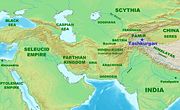
Maes Titianus
Maës Titianus was an ancient traveller of Hellenistic culture who is recorded as having travelled farthest along the Silk Road from the Mediterranean world. In the early 2nd century CE or at the end of the 1st century BC, during a lull in the intermittent Roman struggles with Parthia, his party...
, an ancient Roman Macedonian traveller, penetrated farthest east along the Silk Road
Silk Road
The Silk Road or Silk Route refers to a historical network of interlinking trade routes across the Afro-Eurasian landmass that connected East, South, and Western Asia with the Mediterranean and European world, as well as parts of North and East Africa...
from the Mediterranean world. In the early 2nd century or at the end of the 1st century CE, during a lull in the intermittent Roman struggles with Parthia
Parthian Empire
The Parthian Empire , also known as the Arsacid Empire , was a major Iranian political and cultural power in ancient Persia...
, his party reached the famous Stone Tower, which, according to one theory, was Tashkurgan, in the Pamirs. According to other writers, the 'Stone Tower' must have been located in the Alai Valley, west of Kashgar
Kashgar
Kashgar or Kashi is an oasis city with approximately 350,000 residents in the western part of the Xinjiang Uyghur Autonomous Region of the People's Republic of China. Kashgar is the administrative centre of Kashgar Prefecture which has an area of 162,000 km² and a population of approximately...
.
First Roman embassy
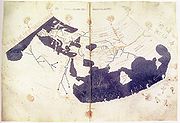
Indian Ocean
The Indian Ocean is the third largest of the world's oceanic divisions, covering approximately 20% of the water on the Earth's surface. It is bounded on the north by the Indian Subcontinent and Arabian Peninsula ; on the west by eastern Africa; on the east by Indochina, the Sunda Islands, and...
. The lively sea trade in Roman times is confirmed by the excavation of large deposits of Roman coins along much of the coast of India. Many trading ports with links to Roman communities have been identified in India and Sri Lanka
Sri Lanka
Sri Lanka, officially the Democratic Socialist Republic of Sri Lanka is a country off the southern coast of the Indian subcontinent. Known until 1972 as Ceylon , Sri Lanka is an island surrounded by the Indian Ocean, the Gulf of Mannar and the Palk Strait, and lies in the vicinity of India and the...
along the route used by the Roman mission.
The first group of people claiming to be an ambassadorial mission of Romans to China was recorded in 166, sixty years after the westbound expeditions of the Chinese general Ban Chao
Ban Chao
Ban Chao , courtesy name Zhongsheng , was born in Xianyang, Shaanxi, and the younger brother of the famous historian, Ban Gu who, with his father Ban Biao, and sister, Ban Zhao, wrote the famous Hanshu, or 'History of the Former Han Dynasty'....
. The embassy came to Emperor Huan of Han China "from Andun (Chinese: 安敦; Emperor Antoninus Pius
Antoninus Pius
Antoninus Pius , also known as Antoninus, was Roman Emperor from 138 to 161. He was a member of the Nerva-Antonine dynasty and the Aurelii. He did not possess the sobriquet "Pius" until after his accession to the throne...
), king of Daqin
Daqin
Daqin is the ancient Chinese name for the Roman Empire and, depending on context, the Near East, especially Syria. It literally means "Great Qin", Qin being the name of the founding dynasty of the Chinese Empire...
(Rome)". (As Antoninus Pius died in 161, leaving the empire to his adoptive son Marcus Aurelius (Antoninus), and the convoy arrived in 166, confusion remains about who sent the mission given that both Emperors were named 'Antoninus'.) The Roman mission came from the south (therefore probably by sea
Sea
A sea generally refers to a large body of salt water, but the term is used in other contexts as well. Most commonly, it means a large expanse of saline water connected with an ocean, and is commonly used as a synonym for ocean...
), entering China by the frontier of Jinan
Jinan
Jinan is the capital of Shandong province in Eastern China. The area of present-day Jinan has played an important role in the history of the region from the earliest beginnings of civilisation and has evolved into a major national administrative, economic, and transportation hub...
or Tonkin
Tonkin
Tonkin , also spelled Tongkin, Tonquin or Tongking, is the northernmost part of Vietnam, south of China's Yunnan and Guangxi Provinces, east of northern Laos, and west of the Gulf of Tonkin. Locally, it is known as Bắc Kỳ, meaning "Northern Region"...
. It brought presents of rhinoceros
Rhinoceros
Rhinoceros , also known as rhino, is a group of five extant species of odd-toed ungulates in the family Rhinocerotidae. Two of these species are native to Africa and three to southern Asia....
horn
Horn (anatomy)
A horn is a pointed projection of the skin on the head of various animals, consisting of a covering of horn surrounding a core of living bone. True horns are found mainly among the ruminant artiodactyls, in the families Antilocapridae and Bovidae...
s, ivory
Ivory
Ivory is a term for dentine, which constitutes the bulk of the teeth and tusks of animals, when used as a material for art or manufacturing. Ivory has been important since ancient times for making a range of items, from ivory carvings to false teeth, fans, dominoes, joint tubes, piano keys and...
, and tortoise
Tortoise
Tortoises are a family of land-dwelling reptiles of the order of turtles . Like their marine cousins, the sea turtles, tortoises are shielded from predators by a shell. The top part of the shell is the carapace, the underside is the plastron, and the two are connected by the bridge. The tortoise...
shell, probably acquired in Southern Asia. About the same time, and possibly through this embassy, the Chinese acquired a treatise
Treatise
A treatise is a formal and systematic written discourse on some subject, generally longer and treating it in greater depth than an essay, and more concerned with investigating or exposing the principles of the subject.-Noteworthy treatises:...
of astronomy
Astronomy
Astronomy is a natural science that deals with the study of celestial objects and phenomena that originate outside the atmosphere of Earth...
from the Romans.
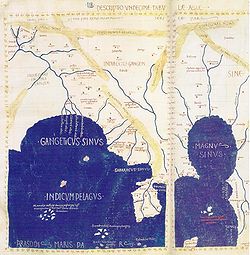
Cartography
Cartography is the study and practice of making maps. Combining science, aesthetics, and technique, cartography builds on the premise that reality can be modeled in ways that communicate spatial information effectively.The fundamental problems of traditional cartography are to:*Set the map's...
of the time, its geographical position is depicted in Ptolemy
Ptolemy
Claudius Ptolemy , was a Roman citizen of Egypt who wrote in Greek. He was a mathematician, astronomer, geographer, astrologer, and poet of a single epigram in the Greek Anthology. He lived in Egypt under Roman rule, and is believed to have been born in the town of Ptolemais Hermiou in the...
's Geographia from c. 150 rather vaguely: On the map, China is located beyond the Aurea Chersonesus ("Golden Peninsula
Peninsula
A peninsula is a piece of land that is bordered by water on three sides but connected to mainland. In many Germanic and Celtic languages and also in Baltic, Slavic and Hungarian, peninsulas are called "half-islands"....
"), which refers to the Southeast Asia
Southeast Asia
Southeast Asia, South-East Asia, South East Asia or Southeastern Asia is a subregion of Asia, consisting of the countries that are geographically south of China, east of India, west of New Guinea and north of Australia. The region lies on the intersection of geological plates, with heavy seismic...
n peninsula. It is shown as being on the Magnus Sinus ("Great Gulf"), which presumably corresponds to the known areas of the China Sea
South China Sea
The South China Sea is a marginal sea that is part of the Pacific Ocean, encompassing an area from the Singapore and Malacca Straits to the Strait of Taiwan of around...
at the time; although Ptolemy represents it as tending to the southeast rather than to the northeast.
Other Roman embassies
Other embassies may have been sent after this first encounter, but were not recorded, until an account appears about presents sent in the early 3rd century by the Roman Emperor to Cao RuiCao Rui
Cao Rui , formally known as Emperor Ming of Wei, was the second emperor of the state of Cao Wei during the Three Kingdoms period of Chinese history. He was a son of Cao Wei's first emperor Cao Pi according to Liu Song dynasty historian, Pei Songzhi, but was a son of Yuan Xi according to modern...
of the Kingdom of Wei (reigned 227–239) in Northern China. The presents consisted of articles of glass in a variety of colours. While several Roman Emperors ruled during this time, the embassy, if genuine, may have been sent by Severus Alexander; since his successors reigned briefly and were busy with civil wars.
Another embassy from Daqin is recorded in the year 284, as bringing presents to the Chinese empire. This embassy presumably was sent by the Emperor Carus
Carus
Carus , was Roman Emperor from 282 to 283. During his short reign, Carus fought the Germanic tribes and Sarmatians along the Danube frontier with success. During his campaign against the Sassanid Empire he sacked their capital Ctesiphon, but died shortly thereafter...
(282–283), whose short reign was occupied by war with Persia.
Chinese annals record other contacts with merchants from 'Fu-lin,' the new name used to designate the Byzantine Empire
Byzantine Empire
The Byzantine Empire was the Eastern Roman Empire during the periods of Late Antiquity and the Middle Ages, centred on the capital of Constantinople. Known simply as the Roman Empire or Romania to its inhabitants and neighbours, the Empire was the direct continuation of the Ancient Roman State...
, the continuation of the Roman Empire in the east, taking place in 643 during the reign of Constans II (641-688). Other contacts are reported taking place in 667, 701, and perhaps 719, sometimes through Central Asian intermediaries. Still other contacts are recorded by the Chinese in the 11th century.
Hypothetical military contact
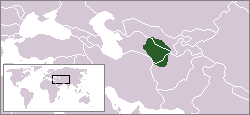
Homer H. Dubs
Homer Hasenpflug Dubs was a pioneering and prolific American Sinologist and polymath. Though best known for his masterful translation of sections of Ban Gu's Han shu , he published on a wide range of topics in ancient Chinese history, astronomy and philosophy...
speculated that Roman prisoners of war who were transferred to the Parthian eastern border might have later clashed with Han troops there.
After losing at the battle of Carrhae
Battle of Carrhae
The Battle of Carrhae, fought in 53 BC near the town of Carrhae, was a major battle between the Parthian Empire and the Roman Republic. The Parthian Spahbod Surena decisively defeated a Roman invasion force led by Marcus Licinius Crassus...
in 54 BCE, an estimated 10,000 Roman prisoners were displaced by the Parthians to Margiana to man the frontier. About 18 years later the nomadic Xiongnu
Xiongnu
The Xiongnu were ancient nomadic-based people that formed a state or confederation north of the agriculture-based empire of the Han Dynasty. Most of the information on the Xiongnu comes from Chinese sources...
chief Zhizhi established a state in the nearby Talas valley
Talas River
The Talas River rises in the Talas Province of Kyrgyzstan and flows west into Kazakhstan. It is formed from the confluence of the Karakol and Uch-Koshoy...
, near modern day Taraz
Taraz
Taraz , is a city and a center of the Jambyl Province in Kazakhstan. It is located in the south of Kazakhstan, near the border with Kyrgyzstan, on the Talas River...
.
Taking up these two strands, Dubs points to a Chinese account by Ban Gu
Ban Gu
Ban Gu , courtesy name Mengjian , was a 1st century Chinese historian and poet best known for his part in compiling the Book of Han. He also wrote in the main poetic genre of the Han era, a kind of poetry interspersed with prose called fu. Some are anthologized by Xiao Tong in his Selections of...
of about "a hundred men" under the command of Zhizhi who fought in a so-called "fish-scale formation" to defend Zhizhi's wooden-palisade fortress against Han
Han Dynasty
The Han Dynasty was the second imperial dynasty of China, preceded by the Qin Dynasty and succeeded by the Three Kingdoms . It was founded by the rebel leader Liu Bang, known posthumously as Emperor Gaozu of Han. It was briefly interrupted by the Xin Dynasty of the former regent Wang Mang...
forces, in the Battle of Zhizhi
Battle of Zhizhi
The Battle of Zhizhi was fought in 36 BC between the Han Dynasty and the Xiongnu chieftain Zhizhi Chanyu. Zhizhi was defeated and killed. The battle was probably fought near Taraz on the Talas River in eastern Kazakhstan, which makes it one of the westernmost points reached by a Chinese army...
in 36 BCE. He claimed that this might have been the Roman testudo formation
Testudo formation
In Ancient Roman warfare, the testudo or tortoise formation was a formation used commonly by the Roman Legions during battles, particularly sieges. Testudo is the Latin word for "tortoise"...
and that these men, who were captured by the Chinese, founded the village of Liqian
Liqian village
Liqian is a defunct county in today's northern province of Gansu in China. Today, the ancient Liqian city is situated in a village called Zhelaizhai.The area of the former Liqian city is known for its inhabitants...
(Li-chien) in Yongchang County
Yongchang County
Yongchang County is a county located in the province of Gansu in China. It belongs to the prefecture of Jinchang. The ancient North Silk Road passes through Yongchang County; numerous Han envoys were sent west along this trackway, some parties exceeding 100 members late in the first millennium BC...
.
However, Dubs' hypothesis has not found acceptance among modern academics. There is no evidence that these men were Romans, and recent DNA testing
Genealogical DNA test
A genealogical DNA test examines the nucleotides at specific locations on a person's DNA for genetic genealogy purposes. The test results are not meant to have any informative medical value and do not determine specific genetic diseases or disorders ; they are intended only to give genealogical...
of the male inhabitants of Liqian does not support the hypothesis.
Newspaper reports in 2010 have claimed DNA tests now confirm "Caucasian origin" for a majority of Liqian residents.
Further reading
- Hill, John E. 2004. The Peoples of the West from the Weilue 魏略 by Yu Huan 魚豢: A Third Century Chinese Account Composed between 239 and 265. Draft annotated English translation. http://depts.washington.edu/uwch/silkroad/texts/weilue/weilue.html
- Leslie, D. D., Gardiner, K. H. J.: "The Roman Empire in Chinese Sources", Studi Orientali, Vol. 15. Rome: Department of Oriental Studies, University of Rome, 1996
- Schoff, Wilfred H.: "Navigation to the Far East under the Roman Empire", Journal of the American Oriental Society, Vol. 37 (1917), pp. 240–249
External links
- Accounts of DaqinDaqinDaqin is the ancient Chinese name for the Roman Empire and, depending on context, the Near East, especially Syria. It literally means "Great Qin", Qin being the name of the founding dynasty of the Chinese Empire...
in the Chinese history of the Later Han Hou Hanshu http://depts.washington.edu/silkroad/texts/hhshu/hou_han_shu.html#sec11 - http://www.silk-road.com/artl/romanenvoy.shtml
- The Origins of Roman Li-chien
- The Lost Legion (Italian) (English)
- Did the Romans settle in Yongchang County, Gansu Province, China?
- The Romans in China. They came,saw and settled
- Romans in China?
- Los Angeles TimesLos Angeles TimesThe Los Angeles Times is a daily newspaper published in Los Angeles, California, since 1881. It was the second-largest metropolitan newspaper in circulation in the United States in 2008 and the fourth most widely distributed newspaper in the country....
: "Digging for Romans in China"; August 24, 2000

